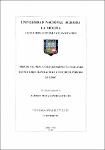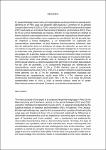Mostrar el registro sencillo del ítem
Brecha salarial entre géneros en el Perú, para los sectores manufactura y comercio, período 2010-2016
| dc.contributor.advisor | Alcántara Santillán, Miguel Angel | |
| dc.contributor.author | Benites Guillén, Allison Nelly | |
| dc.date.accessioned | 2019-11-05T18:36:31Z | |
| dc.date.available | 2019-11-05T18:36:31Z | |
| dc.date.issued | 2019 | |
| dc.identifier.uri | https://hdl.handle.net/20.500.12996/4168 | |
| dc.description | Universidad Nacional Agraria La Molina. Facultad de Economía y Planificación. Departamento Académico de Economía y Planificación | es_PE |
| dc.description.abstract | El presente trabajo tiene como principal objetivo analizar la brecha salarial entre géneros en el Perú para los sectores Manufactura y Comercio en el periodo comprendido entre el 2010 y 2016, usando la Encuesta Permanente de Empleo (EPE) realizada por el Instituto Nacional de Estadística e Informática (INEI). Para tal fin se usó la metodología de Oaxaca–Blinder, la cual consiste en estimar la brecha salarial y descomponerla en un componente explicado por diferencias en características observables como experiencia, escolaridad, tipo de jornada, tipo de empresa y horas trabajadas, y un componente no explicado por características observables, es decir factores discriminatorios. Asimismo, este tipo de estimación tiene un problema, el sesgo de selección, ya que solo se consideran a aquellas personas que se encontraban trabajando al momento de la entrevista, este problema se corrige usando la metodología de Heckman en dos etapas. En la primera etapa se halla un factor de corrección (ratio inverso de Mills) usando un modelo Probit y en la segunda etapa se incorpora este factor de corrección como una variable más al momento de la estimación de la diferencia de salarios. La brecha salarial entre géneros en el sector Manufactura fue de 15% en promedio, y el componente explicado por diferencias en características osciló entre 11.1% y 12.4% mientras que el componente discriminatorio oscilo entre 2.6% y 3.9%. En el sector Comercio la brecha salarial entre géneros fue de 17.7% en promedio, el componente explicado por diferencias en características oscilo entre 4.6% y 4.7%, mientras que el componente discriminatorio osciló entre 13% y 13.1%. A lo largo del periodo comprendido entre el 2010 y 2016 la brecha salarial, tanto en el sector Manufactura como en el sector Comercio, tuvo tendencia decreciente. | es_PE |
| dc.description.abstract | The main purpose of this paper is to analyze the gender wage gap in Peru for the Manufacturing and Commerce sectors in the period between 2010 and 2016, using the Permanent Employment Survey (EPE, in Spanish) conducted by the National Institute of Statistics and Informatics (INEI, in Spanish). The Oaxaca-Blinder methodology was used for this purpose which consists of estimating the wage gap and breaking it down into a component explained by differences in observable characteristics such as experience, schooling, type of working day, type of business and hours worked , and a component not explained by observable characteristics, that is, discriminatory factors. Similarly, this type of estimation has a problem, which is the selection bias, since it will only take into consideration some people who are working at the time of the interview – such problem is solved by using the Heckman methodology in two stages. In the first stage there is a correction factor (Mills inverse ratio) using a probit model and in the second stage this correction factor is incorporated as one more variable at the time of the estimation of the wage difference. The gender wage gap in the Manufacturing sector was 15% on average, and the component explained by differences in characteristics ranged between 11.1% and 12.4% while the discriminatory component ranged between 2.6% and 3.9%. In the Commerce sector, the gender wage gap was 17.7% on average; the component explained by differences in characteristics ranged between 4.6% and 4.7%, while the discriminatory component ranged between 13% and 13.1%. Throughout the period between 2010 and 2016, the wage gap had a decreasing trend, both in the Manufacturing sector and in the Commerce sector. | en_US |
| dc.description.uri | Tesis | es_PE |
| dc.format | application/pdf | en_US |
| dc.language.iso | spa | es_PE |
| dc.publisher | Universidad Nacional Agraria La Molina | es_PE |
| dc.rights | info:eu-repo/semantics/openAccess | en_US |
| dc.rights.uri | https://creativecommons.org/licenses/by-nc-nd/4.0/ | * |
| dc.source | Universidad Nacional Agraria La Molina | es_PE |
| dc.source | Repositorio institucional - UNALM | es_PE |
| dc.subject | Economía | es_PE |
| dc.title | Brecha salarial entre géneros en el Perú, para los sectores manufactura y comercio, período 2010-2016 | es_PE |
| dc.type | info:eu-repo/semantics/bachelorThesis | en_US |
| thesis.degree.discipline | Economía y Planificación | es_PE |
| thesis.degree.grantor | Universidad Nacional Agraria La Molina. Facultad de Economía y Planificación | es_PE |
| thesis.degree.name | Economista | es_PE |
| thesis.degree.level | Título Profesional | es_PE |
| dc.subject.ocde | http://purl.org/pe-repo/ocde/ford#4.05.00 | es_PE |
Ficheros en el ítem
Este ítem aparece en la(s) siguiente(s) colección(ones)
-
EPL-EP Tesis [165]




